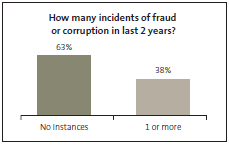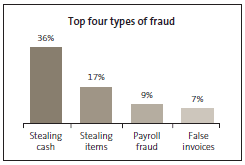Part 3: Incidents of fraud in local authorities
Despite our generally "clean" image, fraud is a fact of business life in New Zealand: 38% of respondents in local authorities were aware of at least one incident of fraud or corruption in their entity within the last two years. This was higher than the overall public sector average of 23%.

Those who knew of an incident in the last two years were then asked for details of the most recent incident. Of the fraud incidents in local authorities, most (87%) were committed by an internal person acting alone, and that staff person was usually working at an operational level.
The money lost by the most recent fraud was mostly low, with 63% reporting losses of less than $10,000. The monetary loss for 14% of fraud incidents was between $10,000 and $100,000, and only 2% were losses of more than $100,000 – but 21% of respondents did not know how much money was lost.
These trends in low dollar values were common to all sectors in the survey. It is not always possible to accurately establish how much money has been lost in a fraud because sometimes the records and the investigation are incomplete.

The most frequent types of fraud within local authorities were:
- theft of cash (36%);
- theft of property, plant, and equipment, or inventory (17% combined);
- payroll fraud (9%); and
- false invoicing (7%).
Theft of property, including cash, was the main fraud risk for local authorities. Close monitoring of cash handling and internal controls are an important part of mitigating this risk.
Respondents said that the fraud occurred because the perpetrator did not think they would get caught (30%), and because internal controls were not followed or were overridden (25%).
Internal tip-offs (other than through a formal whistle-blowing system) were local authorities' most successful mechanism for detecting fraud, with 27% of fraud incidents detected in this way. Internal controls detected 22% of the fraud incidents, and internal audit detected a further 8%. Respondents in other entities reported higher success with internal control systems.
Respondents said that none of the fraud incidents were detected by the external auditor. This is not surprising, because detecting fraud is neither the purpose nor the focus of an external audit.
Strong internal controls and an anti-fraud culture have proven most successful in both preventing and detecting fraud.
As noted earlier, when fraud had occurred, respondents said that 43% of these incidents were reported to the appropriate law enforcement agency. This percentage was in keeping with that of other local government entities and all of the public sector.
Any decision made not to report or respond to fraud can erode staff confidence in the senior management team. It can create a perception that managers are not committed enough to preventing fraud and discourage staff from reporting their concerns. Not reporting fraudulent behaviour also increases the risk that an employee suspected of committing fraud could move to another public entity and continue their dishonest behaviour.
Questions 32 to 40 in Appendix 1 set out the survey response data about incidents of fraud.
page top